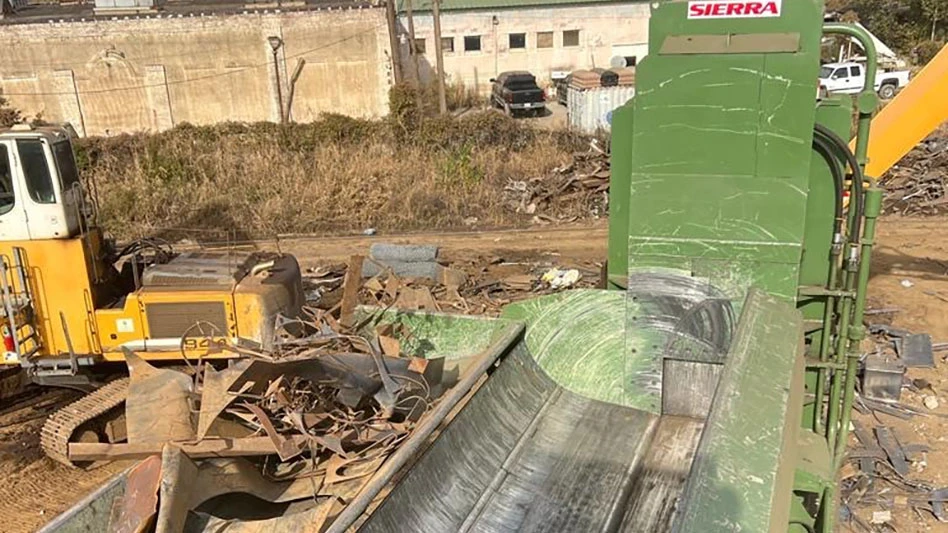
Photo courtesy of Sierra International Machinery
While in some contexts referring to a person or acting performance as “low-energy” is not a compliment, when it comes to industrial processes such as shearing and baling metals, attaining low-energy status is by no means a bad thing.
According to one recycled metals processing equipment veteran, new shears, balers and loggers increasingly are offering design features that allow them to accomplish more without an accompanying increase in fuel consumption.
John Sacco, president of California-based family business Sierra International Machinery, which has roots tracing back to the 1940s, says metal recyclers and their suppliers are keenly aware that reining in diesel fuel or electricity consumption is good for company bottom lines and the environment.
Sacco, through his volunteer leadership roles with the Washington-based Institute of Scrap Recycling Industries (ISRI) and his creation of the “Repurposed” video series, has staked a claim as a recycling industry thought leader, advocating for increased recycling sector positive publicity and education as well as ongoing attention to worker safety.
At the same time Sacco has been involved in wider industry issues, he and his colleagues at Sierra have not taken their eyes off how to provide equipment to the recycling marketplace.
An emphasis heading into 2024, he tells Recycling Today, involves offering shearing, baling and logging equipment with innovative hydraulic fluid circulation techniques and newly designed folding doors that, “without adding more horsepower and without adding more pumps, lets us offer machines that can process more material without consuming more diesel fuel or electricity,” Sacco says.
Sierra, which works with manufacturing, fabrication and engineering partners that have a global footprint, collaborated with those partners to produce machines that accept bulky items, including auto hulks and scrap appliances, so they can “be reduced down to the proper size much faster,” Sacco says.
He says the company initially introduced the design upgrades to its 1,000-to-1,500-ton range of shears, with the upgraded design being offered in more product lines quickly, including in portable car loggers.
The folding doors are one key to “getting material inside the charging box faster.” Sacco adds, “With the folding charge box doors, operators can process 20 to 40 percent more material without adding horsepower or more diesel fuel or electricity consumption.”
The hydraulic system upgrades involve using pumps that enable “hydraulic oil distribution to certain components, allowing those components to move faster and accomplish more without additional horsepower or energy consumption,” he says.
Offering scrap metal processing equipment designed with attention to increased productivity or reining in energy costs is not the sole province of Sierra.
Improved output was the critical need for a Mexican recycling firm when it installed a shear supplied by Belgium-based Lefort earlier this decade. Increased productivity on a mobile platform is the key selling point of a recently introduced model from Italy-based Vezzani.
United States-based Harris, meanwhile, has forged an alliance with Great Scrap Processing Solutions (GPS) of Italy to design and sell the Harris - GPS Series Predator, which Harris calls “the fastest and most powerful scrap baler in its class.” The company describes key features of the Predator as including a three-arm compression system designed to maximize box folding speeds and bale/log weights and a frame designed to offer strength, compression force and durability.
The Aljon 580CL car logger supplied by manufacturer and worldwide distributor S2 Manufacturing, Ottumwa, Iowa, boasts of a 10-foot-by-19-foot (3-meter-by-5.8-meter) chamber and “L” box design it says allows the 580CL to “swallow vehicles as large as full-size van complete with engine transmission and running gear,” processing up to 25 tons of material per hour.
Sacco says he and his colleagues at Sierra engaged in a process common to reputable recycling equipment manufacturers globally. “Over the years, improvements are made by having conversations with customers and then with engineers. The engineers can then come up with a design, and then you work on the manufacturing side to apply it—and, ideally, it does what the theoretical notion indicated it would.”
According to Sacco, recent conversations and initial installations involving recyclers in North America point to a positive reception for the new features, which he considers customer friendly.
“These upgrades are really good for the marketplace in the form of being able to help their bottom lines,” he concludes. “The advantage goes to the purchasers, who are not going to get a bigger fuel bill or electricity bill while boosting their overall processing output.”
Latest from Recycling Today
- Phoenix Technologies closes Ohio rPET facility
- EPA selects 2 governments in Pennsylvania to receive recycling, waste grants
- NWRA Florida Chapter announces 2025 Legislative Champion Awards
- Goldman Sachs Research: Copper prices to decline in 2026
- Tomra opens London RVM showroom
- Ball Corp. makes European investment
- Harbor Logistics adds business development executive
- Emerald Packaging replaces more than 1M pounds of virgin plastic





